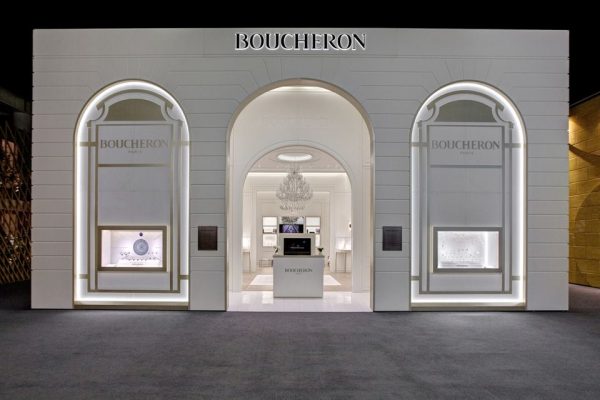Jewelry visual merchandising plays a crucial role in attracting customers and showcasing your jewelry pieces effectively. Here are some tips for jewelry visual merchandising specifically tailored to jewelers
Create a focal point:
Designate a prominent area in your store as a focal point to draw attention. This could be a visually appealing display or a striking jewelry piece that acts as a centerpiece. Use proper lighting to highlight the focal point and make it stand out.
Use props and displays: Incorporate props and displays that enhance the visual appeal of your jewelry. Consider using velvet or suede display trays, stands, or busts to showcase your pieces. These props add a touch of elegance and make it easier for customers to visualize how the jewelry will look when worn.
Group by theme or collection:
Organize your jewelry displays by themes or collections. This helps customers navigate through your store more easily and creates a cohesive and visually appealing arrangement. Grouping similar pieces together can also encourage customers to purchase multiple items.
Consider color coordination:
Pay attention to the color scheme of your displays and make sure it compliments your jewelry. For example, using neutral-colored displays like black or white can make the jewelry pieces pop, while using complementary colors can create an attractive visual contrast.
Incorporate mirrors:
Place mirrors strategically throughout your store to allow customers to try on jewelry and see how it looks. Mirrors also add depth to your displays and make the space appear larger.
Utilize lighting effectively:
Proper lighting is essential to showcase your jewelry in the best possible way. Use different types of lighting, such as spotlights or accent lights, to highlight specific pieces and create a sense of drama. Ensure that the lighting is bright enough for customers to see the details of the jewelry.
Display in multiples:
When showcasing smaller jewelry pieces like earrings or rings, display them in multiples rather than individually. This not only creates a visually appealing arrangement but also suggests that these items are popular choices.
Offer a variety of price points:
Display jewelry pieces at different price points to cater to a wider range of customers. This allows customers with different budgets to find something they can afford and helps to drive sales.
Keep displays clean and organized:
Regularly clean your displays to ensure that the jewelry is presented in its best condition. Arrange the pieces neatly and ensure that everything is in its proper place. A clean and organized display reflects professionalism and attention to detail.
Rotate and update displays regularly:
Keep your displays fresh and interesting by rotating them regularly. This encourages customers to revisit your store and discover new pieces. Consider updating displays to reflect current trends or seasonal themes.
Remember, jewelry visual merchandising is all about creating an inviting and visually captivating space that showcases your jewelry in the best possible light. By implementing these tips, you can create an attractive shopping environment that entices customers and boosts sales.
When it comes to jewelry visual merchandising in India, there are some specific factors to consider due to the cultural context and market preferences. Here are some tips for jewelry visual merchandising tailored to jewelers and jewelry retailers in India:
Embrace cultural aesthetics:
Incorporate elements of Indian culture and aesthetics into your visual merchandising. Use traditional motifs, colors, and materials that resonate with the local customers. This can help create a connection and appeal to the Indian consumer’s sense of identity and tradition.
Highlight craftsmanship and heritage:
Indian jewelry is known for its intricate craftsmanship and rich heritage. Showcase the craftsmanship through detailed displays that highlight the techniques used, such as filigree work, Kundan, Meenakari, or temple jewelry. Educate customers about the cultural significance and history behind different jewelry styles.
Create themed displays:
India has a diverse range of jewelry styles and occasions associated with them, such as weddings, festivals, or religious ceremonies. Create themed displays that cater to these occasions and showcase jewelry pieces suitable for them. For example, create a display focusing on bridal jewelry or festive collections during specific seasons.
Utilize traditional props and displays:
Incorporate traditional props and displays that align with the cultural context. For instance, use elements like antique trunks, silk fabrics, or ethnic motifs to create a visually appealing and immersive experience for customers.
Cater to regional preferences:
India has various regions, each with its own unique jewelry traditions and preferences. Consider the regional market you are catering to and tailor your visual merchandising accordingly. For example, if you are in South India, highlight the traditional temple jewelry or if you are in Rajasthan, showcase Kundan and Meenakari jewelry.
Highlight gemstones and birthstones:
Gemstones hold significant importance in Indian jewelry. Showcase different gemstones prominently in your displays and educate customers about their meanings, benefits, and association with astrology and birthstones. This can enhance the appeal and personalization of the jewelry.
Consider religious symbolism:
Religion plays a crucial role in Indian culture, and jewelry often carries religious symbolism. Incorporate religious motifs and symbols associated with different faiths into your displays, such as Om, Swastika, Ganesha, or the lotus. This can attract customers who seek jewelry with religious significance.
Leverage celebrity endorsements:
In India, celebrity endorsements have a considerable impact on consumer behavior. Consider featuring jewelry pieces worn by popular celebrities or collaborating with influencers who have a significant following. This can generate buzz and attract attention to your store and jewelry collections.
Create an engaging storytelling experience:
Indian consumers appreciate a good story behind the jewelry. Create displays that tell the story of your brand, the inspiration behind specific collections, or the craftsmanship involved. This can help establish an emotional connection with customers and differentiate your brand.
Understanding the Indian consumer’s cultural context and preferences is crucial when it comes to jewelry visual merchandising in India. By incorporating these tips and adapting them to your specific market, you can create a visually compelling and culturally resonant shopping experience that attracts customers and drives sales.

